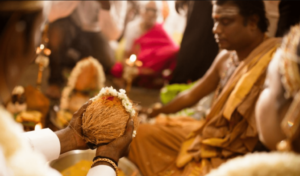Vedas are among the oldest and most authoritative scriptures in Hinduism. The word “Veda” comes from the Sanskrit root “vid,” which means “knowledge” or “wisdom. “Vedas are a collection of ancient texts containing hymns, rituals, and philosophical teachings, while the Upanishads are a subset of texts within the Vedas that delve into profound philosophical discussions about the nature of reality, the self, and spiritual enlightenment. Together, they form the foundation of Hindu thought and spirituality.

There are 4 main Vedas — Rigveda, Samaveda, Yajurveda, and Atharvaveda—that form the foundational scriptures of Hinduism. The Vedas are primarily composed of hymns, prayers, and rituals dedicated to various deities. They cover a wide range of topics, including cosmology, ethics, rituals, and social duties. They are believed to be composed over a period of centuries and are considered to be the most authoritative and sacred texts in Hindu tradition.
ऋग् को धर्म, यजुः को मोक्ष, साम को काम, अथर्व को अर्थ कहा जाता है। इन्ही के आधार पर धर्मशास्त्र, अर्थशास्त्र, कामशास्त्र और मोक्षशास्त्र की रचना हुई जो हिन्दू धर्म के आधार स्तंभ हैं।।
Each Veda (Rigveda, Samaveda, Yajurveda, and Atharvaveda) is divided into several sections, including:
- Samhitas: Collections of hymns and prayers.
- Brahmanas: Ritualistic and ceremonial instructions.
- Aranyakas: Texts with philosophical and meditative content, often intended for forest-dwelling hermits.
- Upanishads: Teachings exploring the nature of reality, the self (Atman), and the ultimate truth (Brahman). The Upanishads are a subset of texts found within the Vedas, specifically within the Aranyakas. The Upanishads are written in the form of dialogues between teachers and students.
In summary, the Vedas are a collection of ancient texts containing hymns, rituals, and philosophical teachings, while the Upanishads are a subset of texts within the Vedas that delve into profound philosophical discussions about the nature of reality, the self, and spiritual enlightenment.

Each Veda consists of Samhitas (collections of hymns), Brahmanas (ritual instructions), Aranyakas (meditative and philosophical teachings), and Upanishads (philosophical texts that explore the nature of reality, the self, and the ultimate truth).
- Rigveda: The oldest and most important Veda, composed in hymns and poetry. It contains hymns praising various deities and exploring the nature of existence and the universe.
- Samaveda: This Veda is primarily concerned with the musical and melodic aspects of chanting the hymns found in the Rigveda. It provides instructions on how to recite the Rigvedic verses in specific musical patterns.
- Yajurveda: The Yajurveda focuses on rituals and ceremonies. It provides instructions and formulas for performing rituals and sacrifices, along with explanations of their symbolic meanings.
- Atharvaveda: This Veda contains a diverse collection of hymns, spells, and incantations. It deals with various practical aspects of life, such as healing, magic, and domestic rituals.








No comment yet, add your voice below!